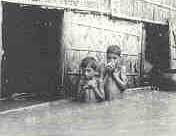Living with floods
 THE book Rivers of life is a result of an exhaustive study based on assessments of existing flood control works in Bangladesh, of related documents, interviews with flood-affected people and Bangladeshi experts, and interactions with donor agencies for a Flood Action Programme (FAP). An excellent book which focusses on the adverse impacts of the existing flood protection schemes, it brings out in no uncertain terms, large potential damages often caused by mindlessly implementing foreign models, without fully understanding local problems and without involving the local people.
THE book Rivers of life is a result of an exhaustive study based on assessments of existing flood control works in Bangladesh, of related documents, interviews with flood-affected people and Bangladeshi experts, and interactions with donor agencies for a Flood Action Programme (FAP). An excellent book which focusses on the adverse impacts of the existing flood protection schemes, it brings out in no uncertain terms, large potential damages often caused by mindlessly implementing foreign models, without fully understanding local problems and without involving the local people.
'Good floods' have brought Bangladesh situated in the delta of the mighty Ganga and the Brahmaputra - invaluable benefits for its agriculture, fishing and navigation. In September 1988, however, "Bangladesh suffered from one of the worst floods in living memory" affecting about two-thirds of the country including Dhaka, and damaging property worth about US $2 billion.
A group of seven industrialised countries called upon the World Bank in July 1989, to co6rdinate the efforts of different countries. Accordingly, in December 1989, the Bank convened an international conference where the FAP was launched. Eleven donor countries and four multilateral agencies are involved in the FAWS formulation.
The FAP basically envisages flood protection by building flood embankments costing about US $10 billion. The period 1990-95 was a study phase costing about US $150 million. About 65 projects worth US $2.5 billion would be implemented in the second phase. The study report is now being reviewed by Bangladesh, donor countries and other agencies.
In developing countries like Bangladesh, the maintenance aspect is often neglected on account of paucity of funds. Of 15 projects, almost 80 per cent had maintenance problems and almost two-thirds of the length of embankments developed breaches.
But floods also recharge ground water, replenish soils with nutrients and provide breeding and feeding grounds for fish - the most important protein diet of the poor in Bangladesh. The claim made by the embankments' protagonists that these help increasing agricultural production, is invalid. One of the most noticeable adverse impacts of embankments has been on the fish production, as these prevent fish migration and annual natural restocking of inland waterbodies. Embankments already constructed have resulted in a permanent loss in annual fish production of 45,000 tonnes so far.
Constructing major reservoirs for storing the excess flood water may ward of flood miseries. But in the Brahmaputra, there is no possibility of constructing any major reservoir in India. Even on Ganga, there are limited possibilities of constructing reservoirs on a few tributaries of the Ganga in Nepal. These will hardly help moderating floods in Bangladesh.
The focus, therefore, has to be shifted to flood management or "living with floods", by reducing human and property loss. To achieve this, measures like scientific and extensive flood forecasting and flood warning systems, raising of habitations and tubewells above flood levels, stocking of adequate food and fodder on raised platforms during the floods, and growing flood - proof/short -term paddy crops should be adopted. In fact, most of the villagers interviewed in Rivers of Life, advocated this philosophy and severely opposed the construction of embankments.
Possessing experiences of close encounters with flood management problems in India for more than 20 years, I entirely agree that the proposed FAP will be an impediment to Bangladesh's economy. Rivers of Life should be paid serious attention to by the Bangladesh government and the FAP's donors.
Related Content
- State of the Climate in Asia 2024
- Affidavit filed by the MoEF&CC related to reduction of glacier sizes leading to an increase in moraine-dammed lakes in Himachal Pradesh and Tibet, 22/04/2025
- European State of the Climate Report 2024
- Climate change impacts in Bangladesh
- Empowering communities in the face of climate change in Egypt
- Libya: storm and flooding 2023- rapid damage and needs assessment
